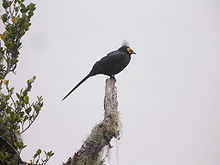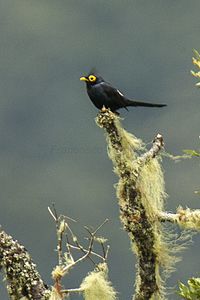| Apo myna | |
|---|---|

| |
| Conservation status | |
 Near Threatened (IUCN 3.1) | |
| Scientific classification | |
| Domain: | Eukaryota |
| Kingdom: | Animalia |
| Phylum: | Chordata |
| Class: | Aves |
| Order: | Passeriformes |
| Family: | Sturnidae |
| Genus: | Goodfellowia Hartert, 1903 |
| Species: | G. miranda |
| Binomial name | |
| Goodfellowia miranda Hartert, 1903 | |
| Synonyms | |
|
Basilornis mirandus | |
The Apo myna (Goodfellowia miranda) is a species of starling in the starling family Sturnidae. The species is also known as the Mount Apo starling or the Mount Apo king starling. It is the only member of the genus Goodfellowia. It is endemic to the Philippines found only in the tropical montane forests of Mindanao. It is threatened by habitat loss.
Description and taxonomy

The Apo myna is a long-tailed starling, 30 cm (12 in) long and weighing around 110 g (3.9 oz). The plumage is mostly glossy black, except for the lower back which is white. The feathers on the head are degenerate and form a floppy crest. There is a large patch of bare yellow skin around the eye and on the cheek creating a distinctive mask. The bill and legs are yellowish. Both the sexes are alike. Juvenile birds resemble adults but have less glossy plumage and have a buff edge to the feathers.
The species was formerly classified in the genus Basilornis, but in 2021 the IOC reclassified it into Goodfellowia, the genus it was initially described in, based on the results of phylogenetic studies. The genus name honors ornithologist Walter Goodfellow, while the specific name is Latin for wonderful or strange.

Behaviour and ecology
Little is known about the behaviour of this species. It eats berries and insects, and forages singly, as pairs or in small groups. Two nests have been found for this species, both in the holes excavated by woodpeckers into trees. One of these nests was 15 m (49 ft) off the ground and made of twigs and leaves.
They are often seen perching on snags sometimes in flocks of up to 20 to 50 birds mixing with other forest species such as coletos.
Ebird describes its voice as "slurred metallic warbles and a sharp, falling 'tsik!' Also makes audible wing beats in flight."
Habitat and conservation status
It is endemic to Mindanao in the south Philippines. Its natural habitat tropical is moist montane forests above 1,250 m (4,100 ft). It is assumed that the species is non-migratory.
The Apo myna is listed as near threatened by the IUCN. It is common in some protected areas, but it has a small and fragmented range, and is becoming rare across some of its range. It is relatively secure for the present, as its habitat is remote and rugged. It is still affected by some logging and clearance for agriculture that may have occurred in lower parts of the elevational range. It is also potentially threatened by mining.
Conservation actions proposed include: surveying range to determine current distribution and abundance, as well as assessing the population and impact of habitat loss; conducting ecological studies to improve understanding of its habitat — particularly, its tolerance to habitat degradation; protecting areas of suitable habitat, especially at lower elevations within the species' altitudinal range, and safeguarding against logging and encroachment.
References
- ^ BirdLife International (2023). "Goodfellowia miranda". IUCN Red List of Threatened Species. 2023: e.T22710968A228041458. doi:10.2305/IUCN.UK.2023-1.RLTS.T22710968A228041458.en.
- ^ Craig, A. & Feare, C. (2017). Apo Myna (Basilornis mirandus). In: del Hoyo, J., Elliott, A., Sargatal, J., Christie, D.A. & de Juana, E. (eds.). Handbook of the Birds of the World Alive. Lynx Edicions, Barcelona. (retrieved from http://www.hbw.com/node/60815 on 19 March 2017).
- Jobling, J. A. (2017). Key to Scientific Names in Ornithology. In: del Hoyo, J., Elliott, A., Sargatal, J., Christie, D.A. & de Juana, E. (eds.) (2017). Handbook of the Birds of the World Alive. Lynx Edicions, Barcelona. (retrieved from www.hbw.com).
- Museum, United States National (1909). Proceedings of the United States National Museum. Smithsonian Institution Press.
- Allen, Desmond (2020). Birds of the Philippines. Barcelona: Lynx and Birdlife International Fieldguides. pp. 310–311.
- "Apo Myna". Ebird. Archived from the original on 2020-03-29.
| Taxon identifiers | |
|---|---|
| Goodfellowia miranda | |
| Basilornis mirandus | |